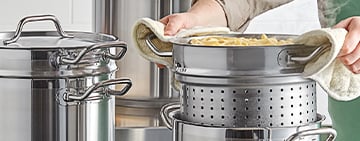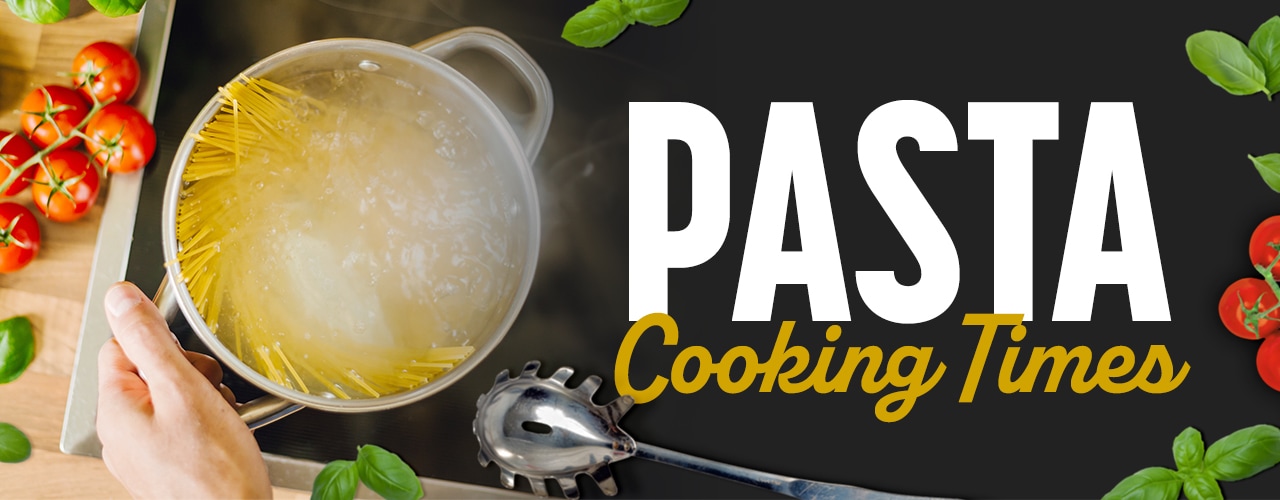
Cooking pasta may seem like a simple task, but achieving the perfect texture and consistency can be a bit more challenging than it appears. Understanding the cooking times for different pasta varieties is crucial for commercial kitchens that strive to create a complete menu full of well-cooked pasta dishes for their customers. Cooking times can vary depending on the type of pasta, its thickness, and the desired doneness. Below, we examine the cooking times of some of the most popular types of pasta and how different features of pasta have an effect on cooking time.
How to Cook Pasta Al Dente
The term "al dente" translates to "to the tooth" in Italian, and it refers to pasta that is cooked until it is still firm when bitten into. Achieving the perfect al dente texture can greatly enhance the taste and overall quality of your pasta dishes. When cooking your pasta al dente, you should set your timer for one minute less than the recommended cooking time. This will ensure your pasta is cooked, yet still retains a level of firmness and a slight resistance when bitten into.
To determine if the pasta is cooked al dente, taste a piece of the cooked pasta. The pasta should still have a slight resistance when bitten into, indicating that it is not fully cooked. It should not be hard or crunchy but rather have a firm yet tender texture.
Fresh Pasta vs Dry Pasta
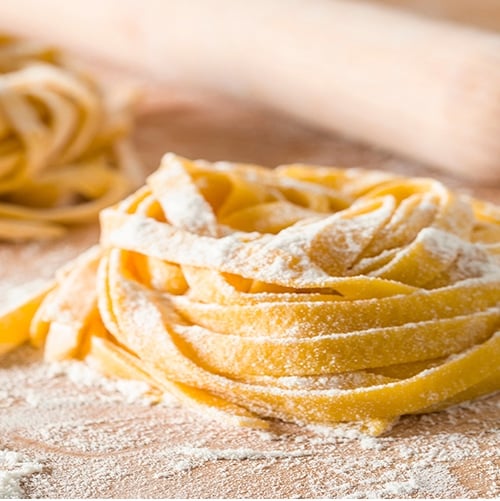
Fresh pasta and dry pasta are two common types of pasta that are used in commercial kitchens, with both types of pasta having their own unique qualities and cooking times. Fresh pasta is made with eggs and flour, giving it a rich and delicate flavor. It has a soft and tender texture that can be easily manipulated into various shapes and sizes. On average, fresh pasta cooks faster than dry pasta.
Due to its makeup of durum wheat flour and water, dry pasta takes longer to cook. It has a firmer texture and a slightly nuttier flavor compared to fresh pasta. This firmer texture makes dry pasta ideal for serving al dente or pairing with heavier pasta sauces.
Fresh Pasta Cooking Time
Fresh pasta is a popular choice for many chefs and commercial kitchens due to its delicate texture and rich flavor. Fresh pasta typically cooks much faster than dried pasta due to its higher moisture content and lack of drying process. In commercial kitchens, where large quantities of fresh pasta may need to be cooked at once, it is advisable to work in batches to ensure even cooking. This will prevent overcrowding of the pot and help maintain the pasta's integrity.
Dry Pasta Cooking Time
The rough and firm texture of dry pasta helps hearty sauces cling to it, making them a perfect match. Due to the texture, dry pasta is typically cooked longer, taking around 8 to 12 minutes to cook al dente. It's important to note that this is just a general guideline, as the cooking time for dry pasta can vary depending on the type and thickness of the pasta.
Pasta Cooking Times Video
Check out the video below for a visual overview of the cooking times of each type of pasta:
Pasta Cooking Times By Type
When it comes to cooking pasta, it's important to know that different types of pasta have varying cooking times. These cook times change based on the size and thickness of the pasta, as well as the ingredients used to make it. Understanding these cook times allows you to elevate the taste and texture of your restaurant's pasta dishes.
1. Spaghetti Cook Times
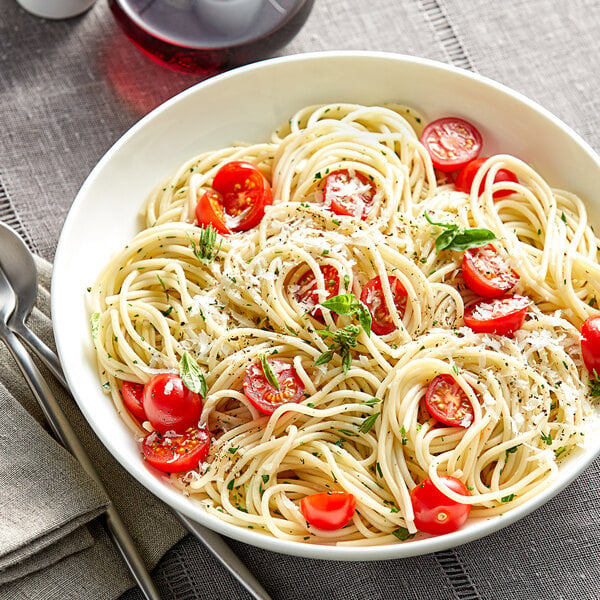
Spaghetti is a popular pasta shape that is enjoyed in various cuisines around the world. The thin strands of spaghetti result in quicker cooking times when compared to some other pasta, so be careful not to overcook.
- Fresh Spaghetti Cook Time - Cooks in 2-3 minutes. It is recommended to start testing for doneness around the 2-minute mark and continue checking every 30 seconds until the pasta is cooked to your liking.
- Dry Spaghetti Cook Time - Cooks in 8-12 minutes. Start testing doneness around the 8-minute mark and continue checking every minute until the pasta is cooked to your preference.
2. Orzo Cook Times
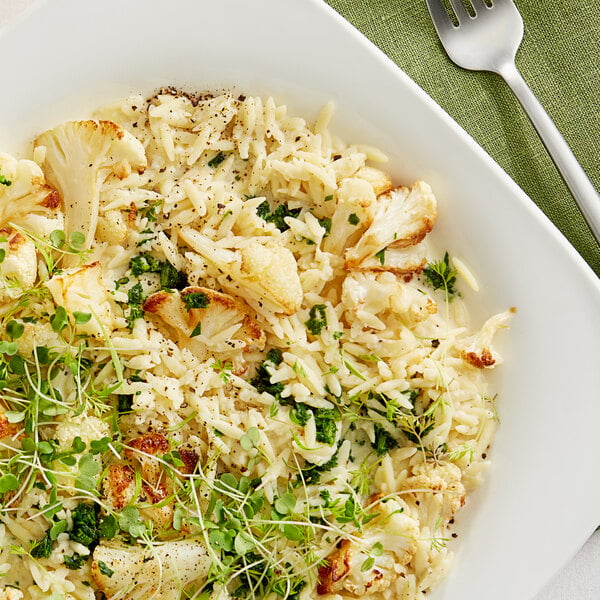
Orzo, a small pasta that resembles rice, is a versatile ingredient that can be used in a variety of dishes. Orzo typically cooks in about 8 to 10 minutes, but this can vary depending on the brand and the desired level of doneness. If you prefer your orzo to be firmer, keep an eye on the orzo as it cooks to ensure it doesn't become overcooked or mushy.
- Fresh Orzo Cook Time - Cooks in 5-7 minutes. Ensure you're checking the pasta's doneness every thirty seconds after 5 minutes have passed to avoid overcooking.
- Dry Orzo Cook Time - Cooks in 8-10 minutes. To ensure that your dry orzo is perfectly cooked, taste-test it as it nears the 8-minute mark and continue checking every minute thereafter.
3. Penne Cook Times
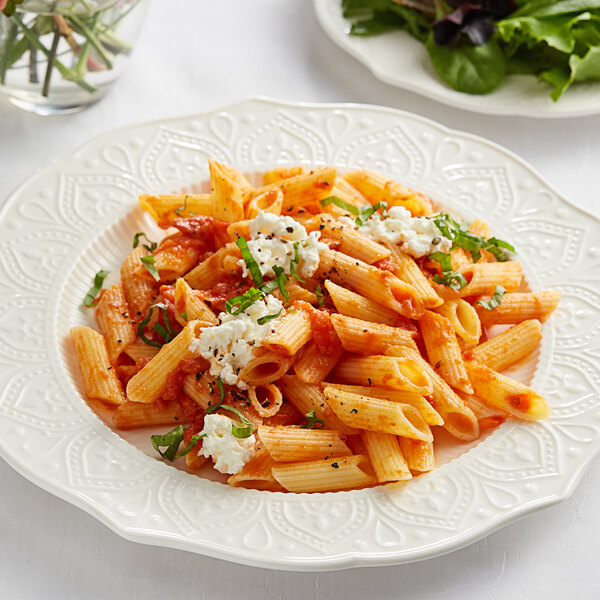
On average, penne pasta typically takes about 11-13 minutes to cook, however this can vary depending on brand and thickness. It's important to cook your penne just right, as overcooking penne pasta can result in a mushy texture while undercooking can leave it too firm and chewy.
- Fresh Penne Cook Time - Cooks in 2-3 minutes. This short cooking time ensures that the penne pasta retains its shape and doesn't become mushy.
- Dry Penne Cook Time - Cooks in 11-13 minutes. This longer cooking time will result in al dente penne, allowing the pasta to absorb the water and soften while retaining a slight firmness in the center.
4. Linguine Cook Times

Linguine, a popular type of pasta, is known for its long, narrow shape and flat edges. It is a versatile pasta that can be paired with a variety of sauces and ingredients, making it a favorite choice for many commercial kitchens.
- Fresh Linguine Cook Time - Cooks in 2-4 minutes. It is crucial to monitor the pasta closely to avoid overcooking, as fresh linguine can quickly become mushy if left in boiling water for too long.
- Dry Linguine Cook Time - Cooks in 8-12 minutes. Similar to fresh linguine, dry linguine can quickly become mushy so it is crucial to check the pasta for doneness by sampling a piece. The dry linguine should be cooked al dente, with a slight firmness in the center.
5. Rigatoni Cook Times
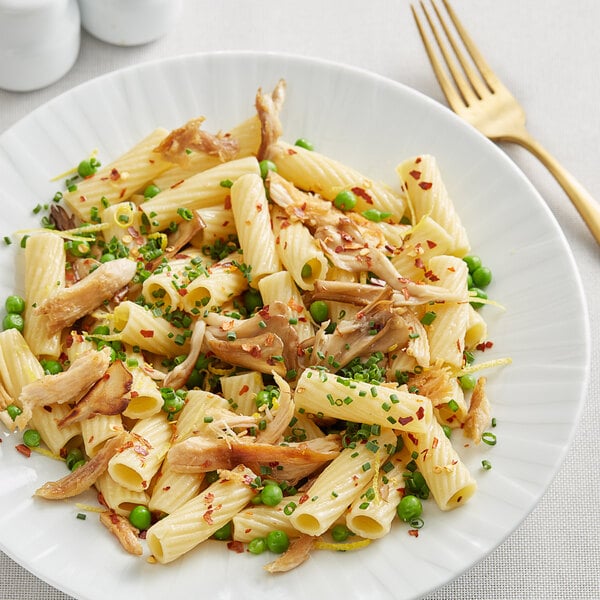
Rigatoni is a popular type of pasta known for its large, cylindrical shape and ridges. Its hollow center and ridges make it a great choice for holding onto sauces and other ingredients, allowing it to serve as a versatile option in a variety of dishes. When cooking rigatoni, it is important to follow the recommended cooking time to ensure that it is cooked to perfection and can easily absorb and hold onto sauces.
- Fresh Rigatoni Cook Time - Cooks in 2-3 minutes. Fresh rigatoni is made with a higher percentage of egg, giving it a softer texture and a shorter cooking time compared to dry rigatoni.
- Dry Rigatoni Cook Time - Cooks in 8-12 minutes. Dry rigatoni needs more time to rehydrate and soften, resulting in a much longer cooking time than fresh rigatoni.
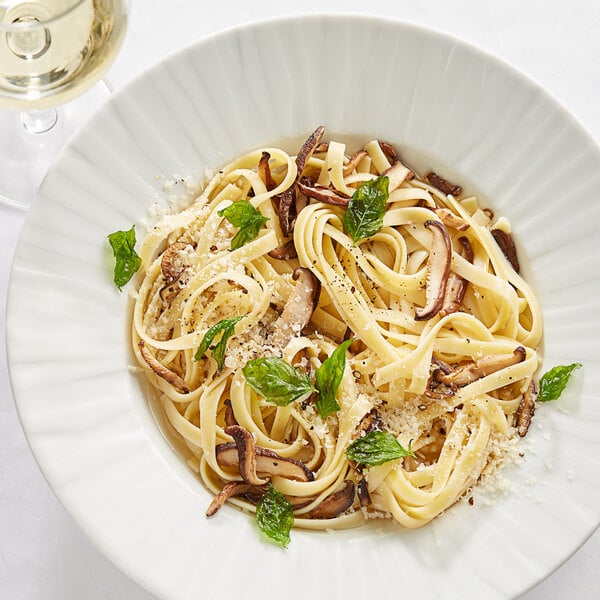
6. Fettuccine Cook Times
Fettuccine is a popular type of pasta that is known for its long, flat shape. When cooked properly, fettuccine should have a tender yet slightly firm texture, allowing it to hold up well with various sauces and ingredients.
- Fresh Fettuccine Cook Time - Cooks in 2-4 minutes. When cooked correctly, fresh fettuccine is a popular choice in dishes like fettuccine alfredo due to its delicate texture and rich flavor.
- Dry Fettuccine Cook Time - Cooks in 8-12 minutes. It is recommended to start testing for doneness around the lower end of the suggested cook time range, around the 8-minute mark, and adjust accordingly based on personal preference.
7. Rotini Cook Times

Rotini is a popular pasta shape that is known for its spiral or helical shape. This unique shape not only adds visual appeal to dishes but also helps to hold onto sauces and ingredients, making it a versatile choice for a variety of recipes.
- Fresh Rotini Cook Time - Cooks in 2-3 minutes. Fresh rotini pasta is typically made with eggs and flour, giving it a delicate and tender texture. Due to its freshness, it requires a shorter cooking time compared to other fresh pasta varieties.
- Dry Rotini Cook Time - Cooks in 8-10 minutes. Dry rotini pasta is made from semolina flour and water and is the most commonly used type of rotini in commercial kitchens. It has a firmer texture and requires a longer cooking time to achieve the desired consistency.
8. Gnocchi Cook Times
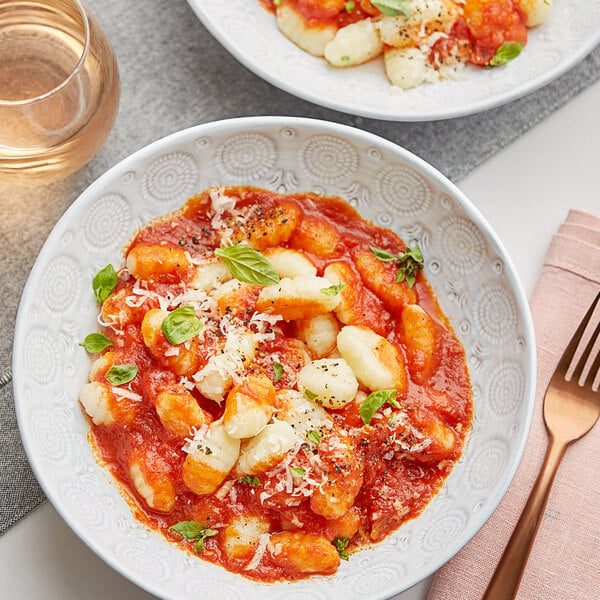
The cook time for gnocchi is relatively short compared to other types of pasta, due to its soft, pillow-like texture. To determine if the gnocchi is cooked, you can perform a simple test. Take one gnocchi and cut it in half. If the center is cooked through and no longer doughy, then the gnocchi is ready to be drained. If the center is still doughy, continue cooking for another minute and test again.
- Fresh Gnocchi Cook Time - Cooks in 2-3 minutes. Once the gnocchi begins to float to the surface of the boiling water, it is a good indicator that it is cooked and ready to be removed from the pot.
- Dry Gnocchi Cook Time - Cooks in 4-5 minutes. Similar to fresh gnocchi, the dry gnocchi will also float to the surface of the boiling water once it is cooked through.
9. Macaroni Cook Times
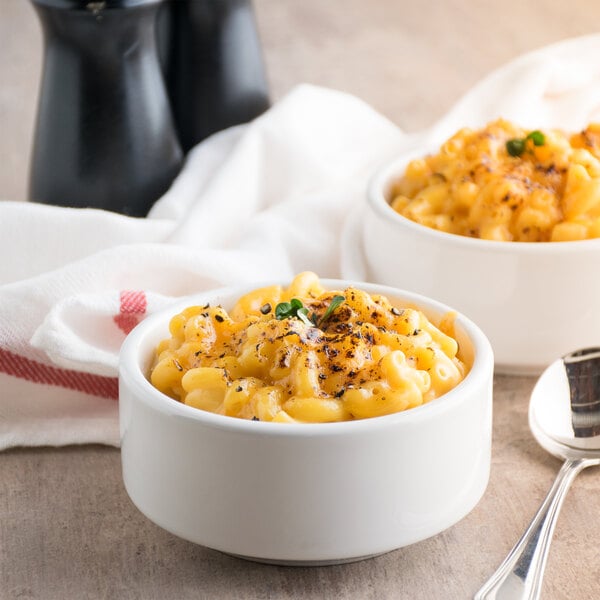
As a general rule of thumb, small macaroni shapes such as elbow macaroni and small shells typically cook in about 8-10 minutes. Larger macaroni shapes like large shells may require a few extra minutes, usually around 10-12 minutes. However, it is always recommended to taste-test the pasta during the cooking process to ensure it reaches the desired texture.
- Fresh Macaroni Cook Time - Cooks in 2-4 minutes. Fresh macaroni is made from a dough consisting of flour, eggs, and water. It is important to keep a close eye on fresh macaroni, especially the smaller varieties, as its quick cooking times can easily lead to overcooking if you're not careful.
- Dry Macaroni Cook Time - Cooks in 8-12 minutes. The cooking time for dry macaroni varies significantly depending on their size, so it's important to frequently test the texture to ensure it's cooked to the perfect consistency.
10. Cavatappi Cook Times

Cavatappi, also known as cellentani, is a unique pasta shape that is characterized by its long, twisted, and tubular appearance. This corkscrew-like pasta is perfect for holding onto sauces and can add a fun and playful element to your dishes.
- Fresh Cavatappi Cook Time - Cooks in 2-3 minutes. Fresh cavatappi is a great option for those who prefer a softer, more delicate texture. Since fresh cavatappi retains more moisture than its dried counterpart, it tends to cook faster.
- Dry Cavatappi Cook Time - Cooks in 8-10 minutes. Dry cavatappi is more commonly used in commercial settings due to its longer shelf life and convenience. While the lower moisture content extends the pasta's shelf life, it results in a longer cooking time being required.
11. Ziti Cook Times
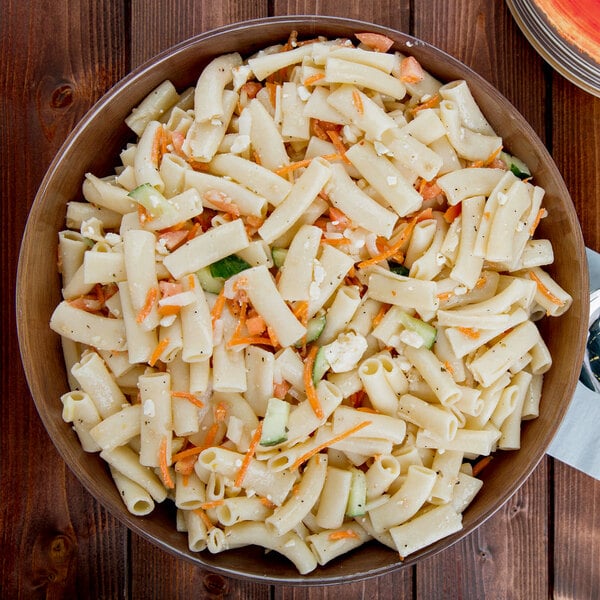
Ziti is a popular pasta shape that is characterized by its long, hollow tubes. It is often used in baked pasta dishes, such as ziti al forno, as well as in pasta salads and casseroles. It is critical to cook ziti correctly to allow the pasta to match the texture and flavors of the other ingredients in these dishes.
- Fresh Ziti Cook Time - Cooks in 3-5 minutes. Fresh ziti is a great option when looking for a soft and tender texture to complement other foods.
- Dry Ziti Cook Time - Cooks in 8-12 minutes. Dry ziti is made from durum wheat semolina and offers a firmer texture when cooked, making it more popular in commercial settings.
12. Fusilli Cook Times

Fusilli are similar to rotini, as their shape makes them great at holding onto thick and creamy sauces. Cooking fusilli correctly is key to getting that perfect texture and allows the pasta to pair perfectly with hearty and meaty sauces.
- Fresh Fusilli Cook Time - Cooks in 2-4 minutes. Fresh fusilli dough has a high moisture content due to the presence of eggs and water, resulting in faster cooking times.
- Dry Fusilli Cook Time - Cooks in 8-10 minutes. Dry fusilli is made from durum wheat semolina and does not contain eggs, resulting in a lower moisture content and longer cooking times.
13. Capellini Cook Times
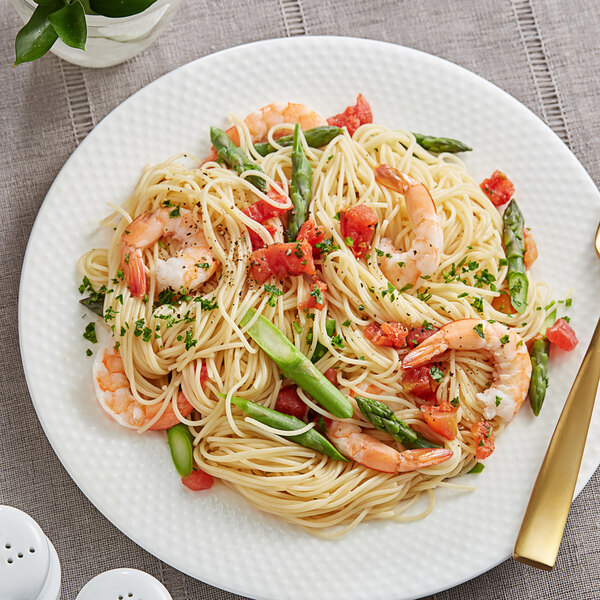
Capellini, also known as angel hair pasta, is a delicate and thin pasta variety that is often used in light and delicate dishes. Due to its delicate nature, it cooks faster on average than many other types of pasta.
- Fresh Capellini Cook Time - Cooks in 1-3 minutes. Fresh capellini cooks very quickly and requires minimal time in boiling water, making it important to closely monitor the pasta during this short cooking time to avoid overcooking.
- Dry Capellini Cook Time - Cooks in 3-5 minutes. Although dry capellini has a longer cook time than its fresh counterpart, this pasta has a much shorter cook time than other dry pasta variants.
Pasta Cooking Tips
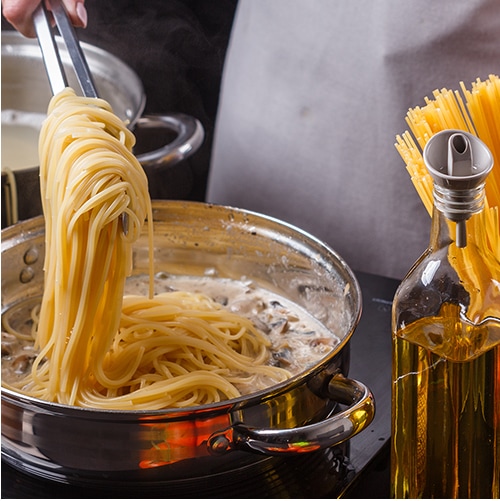
Although cooking times vary based on the type of pasta and its thickness, there are a few general rules of thumb you should follow when cooking pasta. Below, we’ve outlined some of the most important tips you can utilize to help ensure your pasta is cooked to perfection every time:
- Choose the Right Cooker - A general rule of thumb is to use a pasta cooker that is at least four times the volume of the pasta you are cooking. This allows the pasta to move freely during cooking, preventing clumping and ensuring even cooking.
- Salt the Water - While not required, adding salt to the cooking water is great for enhancing the flavor of the pasta and preventing it from sticking together. As a general guideline, use about 1 tablespoon of salt for every 4 quarts of water.
- Stir Pasta - Stirring helps to prevent the noodles from sticking to the bottom of the pot or clumping together. It also ensures that the pasta cooks evenly and prevents it from becoming too mushy before serving.
- Test for Doneness - The cooking time mentioned on the pasta package is just an estimate, so it's important to test the pasta for doneness to achieve the desired texture. To do this, take a piece of pasta and bite into it. Avoid overcooking the pasta, as it can become mushy and lose its shape.
- Serve Immediately - Once the pasta is cooked to perfection, it's important to serve it immediately to enjoy its optimal taste and texture. Leaving the pasta sitting in the pot or strainer can cause it to continue cooking and become overdone.
Understanding the cooking times for different types of pasta is essential for commercial kitchens to ensure consistency and quality in their pasta dishes. By following the recommended cooking times and considering preferences, chefs and cooks can create delightful pasta dishes that satisfy their customers' taste buds and enhance the overall dining experience.





